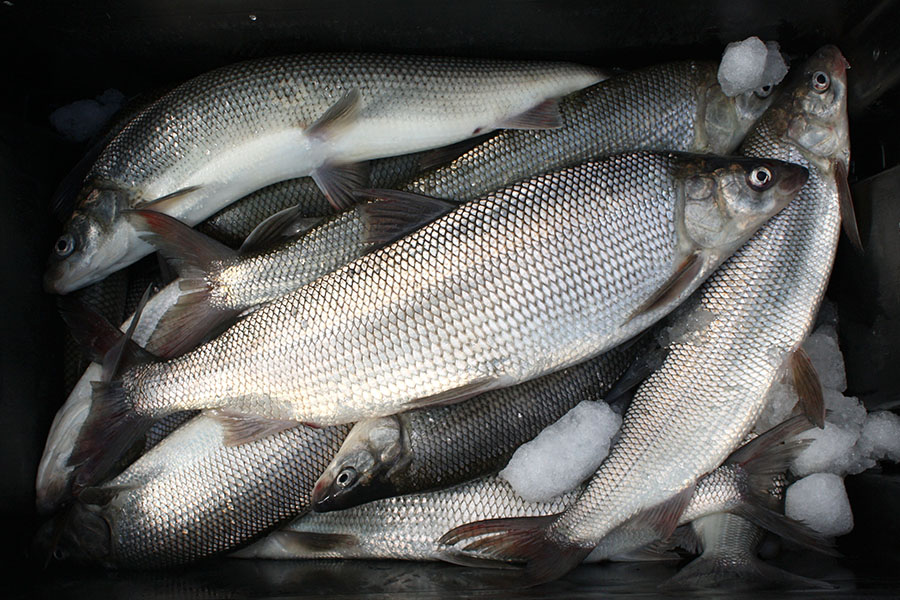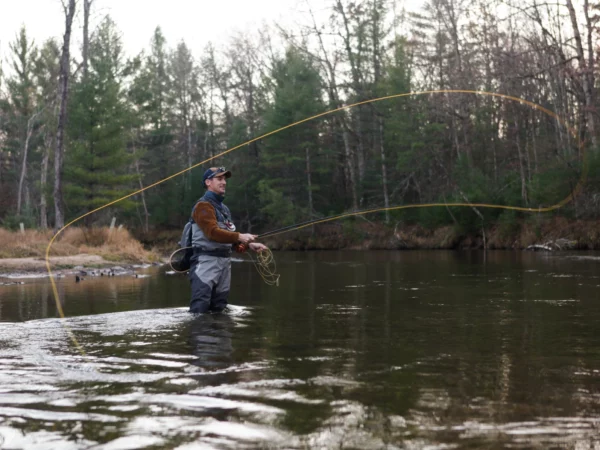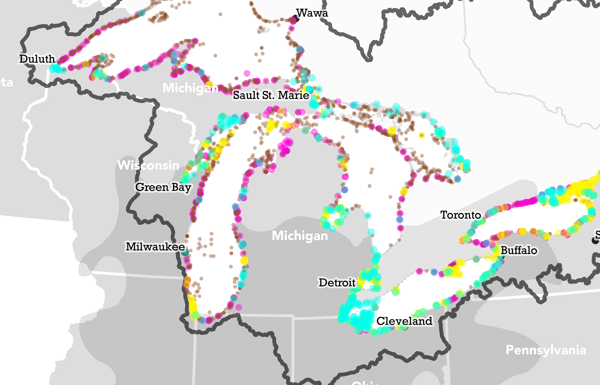
While Great Lakes fish populations are constantly in a state of flux, one species has declined precipitously in the last decade: lake whitefish. But Great Lakes leaders and fisheries managers are looking ahead in planning to do more with less.
And in the case of whitefish, a lot more.
The Conference of Great Lakes and St. Lawrence Governors and Premiers (CGL) recently launched a project called the 100% Whitefish Initiative. It aims to radically transform traditional commercial whitefish operations from simple to complex while vastly increasing the value of a now-limited resource. The new endeavor will pool the resources of more than 15 partners including American and Canadian political leaders, private companies and state and tribal officials.
The search for a way to preserve an industry with a shrinking natural resource brought the Iceland Ocean Cluster (IOC) into focus. IOC was founded by Thor Sigfusson in 2012 with a dozen companies on-site. There are now 70.
So what is it? And could it work as a model for the Great Lakes’ new whitefish initiative?
Deep thinking on fish
Think of the Ocean Cluster as a fish think tank in Reykjavik, Iceland. While it was established to maximize the utilization of a shrinking cod population in the Atlantic Ocean, it’s expanded into an exporter of economic ideas.
“What we’ve been doing here in Iceland is really to build a network of people that can support various new product developments,” Sigfusson said.
While it begins with the fishermen, it goes far beyond into other industries and products.
“What’s been so important is bringing in people that have never been into fisheries, letting them explore opportunities to take some byproducts, like the liver or the skin or bones or intestines and say ‘Okay, is there anything here we might be able to create some value from?’” he said.
According to Sigfusson, the project is much like a business incubator, meant to spawn ideas and innovation. Traditionally, commercial fishing operations catch fish and cut fish filets which are sold to food processors, restaurants or retail sites.
The remaining fish carcasses, which can be as much as half the weight, are sold for pennies per pound or given away or dumped. Most often, they’re used for production of fertilizer products, fish feed or pet food products. Much of them end up in landfills, which includes a cost for disposal.
The whitefish project aims to mimic IOC’s transformation of Icelandic cod, where currently about 90 percent of each fish is utilized for a variety of products.
More than filets on ice
In Iceland, cod are caught, fileted and shipped around the world both fresh and frozen. But instead of discarding the rest of the fish, it’s really just the beginning.
Many items now emerge from Iceland’s cod, including durable leather.
Fish leather is actually a thing. Cod leather is popular though other fish including tilapia, salmon and perch are harvested from commercial fisheries then processed and dyed to create durable, fashionable leather. Fish leather is used in clothing, handbags, wallets, watch bands and other products.
In Iceland and Norway, cod are dried outside in the open air without chemicals or salt and sold as stockfish. Some are heads only, others are chunked portions of the body and others are longer sections or a whole fish.

Commercially harvested whitefish. (Photo courtesy of Michigan Sea Grant)
The drying process takes place during winter or spring, depending on location and is said to produce a product that with a unique, sought-after taste unlike the typical fish flavor. Websites that ship Icelandic cod worldwide advertise 30-pound packages of “stockfish heads” for $349 plus shipping. Bundles of whole round dried stockfish cod totaling 100 pounds can be had for about $1,749 plus shipping.
But fish is for more than eating or wearing, of course. It can also be for drinking.
The more (products) the merrier
“One of the things that struck me when I was over in Iceland and I saw some of these products, is they actually have a beverage, an energy drink that’s made with fish collagen,” said Dan Eichinger, director of the Michigan Department of Natural Resources. “It sounds disgusting but it’s delicious, actually. Tastes like a LaCroix but a little sweeter version.”
IOC companies have also harnessed the healing properties of fish in their effort to add value to a diminished commodity.
“They’ve also figured out that different types of fish skin does really well healing wounds on humans much more effectively and efficiently than some other traditional bandages and grafts,” Eichinger said. “People who are very smart and very forward-thinking are taking these raw materials and are going to be helping people in the long run.”
The Federal Drug Administration has approved multiple cod skin medical products in recent years, including those made from Icelandic cod and used in surgical procedures and severe burn treatments.
The IOC fish matrix also includes products in the cosmetics, fish oil and food supplements categories. Each product line added to the possibilities means more value per fish.
The average value of each cod to commercial fishermen when traditionally fileted is about $12 according to IOC. When all value from all products is totaled in the IOC model, a single fish could represent a gross value of up to $3,500 for all the businesses that utilize a portion of that fish through all processes. Remarkably, that raises the possible value of a single cod more than 28,000 percent from its traditional market use.
Can the Great Lakes replicate Iceland’s cod industry?
David Naftzger, executive director of the CGL, said he hopes so. The 100% Whitefish Initiative is a perfect opportunity for his organization to meet its mission: grow the region’s economy and protect the world’s largest freshwater system.
“It was just launched in Detroit, and the focus is on using more of the whitefish that’s caught,” he explained. “Most of the fish goes to a landfill and that’s unused and it represents wasted value.”
Over the last century and a half, Great Lakes fish populations have fluctuated, sometimes wildly. One fish, the blue pike (believed to have been a subspecies of walleye) has disappeared completely. Others like whitefish still remain but like blue pike did, have suffered due to overfishing and changes in habitat including pollution and the availability of needed proteins and small forage fish.
Scientists believe the fish have fallen victim to invasive zebra and quagga mussels, which eat the phytoplankton and zooplankton tiny whitefish need to survive. So the need to improve the commercial fishing scene should happen while also preserving the fishery, researchers say.
Great Lakes, North Atlantic
As an early step, whitefish caught from the Great Lakes have been sent to IOC labs in Reykjavik for an intense battery of lab testing. The results could determine the financial future of people who rely on harvesting whitefish from the lakes.
“It’s biotechnical testing, so they’re looking at underlying chemistry of the different parts of the fish so they can compare it to cod and other species of fish in the industry they’ve worked with,” Naftzger explained. “Already collagen-based products were identified as high potential.”
The possibility of wide-ranging applications for whitefish beyond the basic fish filets business would be transformational for the Great Lakes commercial fishing industry.
“I wouldn’t say commercial fishing in Michigan is dead at all,” Eichinger said. “It’s extremely important to tribal citizens that commercial fishing remains a part of tribal identity in Michigan, so it’s important for us to continue to find ways to support that activity.”
While the industry is not dead, he said, it is changing.
“This is one of the ways we’re trying to manage those changes,” Eichinger said. “When you see those declining fish stocks, what does that mean? Probably that over time we need to be harvesting fewer fish. And if that’s the answer, then we’ve got to figure out how we can maximize the value of the fish we can catch.”
Michigan tribes have long relationship with whitefish
The Grand Traverse Band of Ottawa and Chippewa Indians and Little Traverse Bay Band of Odowa Indians are part of the 100% Whitefish project team. Both have deep historical ties to whitefish and current commercial interests in whitefish harvests.
“Whitefish has been pretty instrumental on the lakes from a commercial standpoint and a subsistence standpoint, but it’s starting to struggle quite a bit now,” said Doug Craven, director of the Little Traverse Bay Band’s department of natural resources, and a member. “Their numbers are down and there are some issues with it.”
He said historically, whitefish comprised about 60 to 70 percent of his tribe’s commercial harvest up until about five years ago, with the balance being lake trout. But that’s completely reversed now, with 70 to 80 percent lake trout and in some places, as much as 90 percent.
“These are family operations,” Craven said. “Typically, some of them have been doing it for generations. Our fishermen are small boat commercial gill net fishermen so they’re not running large operations, they’re running smaller operations with boats 25 feet or so in length.”
Craven said he’s hopeful that the new project can send whitefish harvests in a new, more profitable direction.
“It’s pretty amazing the variety of products they can make and the versatility of the cod species, so we’re hoping that same type of thing will come through when we find out,” he said. “A lot of innovative ideas and some outside-the-box things. It will be interesting to see what they can come up with.”
Back to the Fish Think Tank
Supporters of the 100% Whitefish campaign are optimistic that new ideas for whitefish will be coming soon.
“The labs over there have already done this type of work, and they know what they’re looking for,” Eichinger said. “They’re going to return back a kind of readout of what are the possibilities for collagen and fish oil and for fish leather and biomedical applications.”
He said the 15-plus initiative members are eager to learn about the future potential of Great Lakes whitefish. And Sigfusson said IOC staff and collaborators are also eager to envision a future for this iconic species that both helps fishermen, the fish they seek and many others beyond the docks and fish markets.
“The mindset of the young people really fits well with what we need in the seafood industry right now because it has a kind of closed loop so far, because of the mindset,” he said. “These young people tend to publish their ideas, kind of spread the word and get new ideas in from various sources.”
Spreading the word and bringing new people and ideas into a cluster is a good thing, according to Sigfusson.
“We’re not trying to tell them what to do but we are trying to inspire them to do things we think are important. One thing we emphasize is this sort of hands-on approach – meet with fishermen, meet with the people in academia and try to do the matchmaking. Try to ensure that people who have never met before are talking about how to develop your product or develop various ideas that can help build more value for the fishermen and the industry in general,” he said.
Sigfusson said he was especially impressed with one tribal fisherman.
“He told me he looks at fishing the Great Lakes just like the forest: that we have to keep in mind we can’t cut down the whole forest at once, we need to be harvesting it sensibly and that’s what we need to do with the fishing,” he said. “So I felt there was a strong sustainability message there.”
Catch more news at Great Lakes Now:
Weighted Walleye: The fallout of the Lake Erie fishing tournament
Fish scientists: From childhood aspirations to Amazonian expeditions
Featured image: Lake whitefish are harvested from a trap net in Green Bay on Lake Michigan. (Photo courtesy of Titus Seilheimer, Wisconsin Sea Grant)




